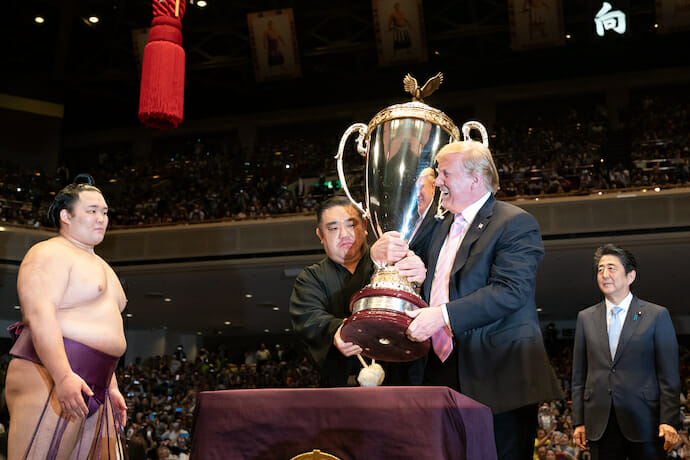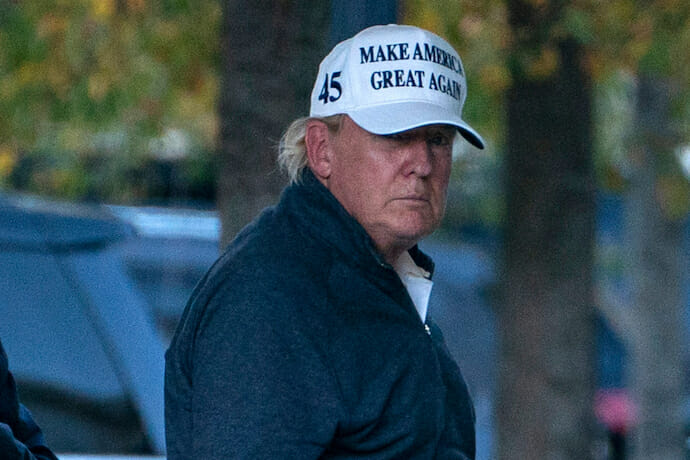Revisiting 2016’s ‘Donald Trump’s The Art of the Deal: The Movie’ and the Comedy of the Trump Era
Two writers discuss why satirizing Donald Trump is exceedingly difficult.
Will Mann: At the height of the 2016 presidential primary, right as there was the collective bafflement that hey, the host of The Apprentice could actually win the Republican nomination, comedy website Funny or Die released Donald Trump’s The Art of the Deal: The Movie, a 50-minute presentation where Johnny Depp, under heavy prosthetics, played the then future-president. The film was released exclusively to the Funny or Die website on February 26, 2016.
I remember watching it and loving it at the time. It felt subversive, unapologetically in-your-face, and very much deliberately mocking its central target for ridicule. Moreover, at the end of it, Depp’s Trump comes from the future of 2017 to tell his 1980s counterpart that he will indeed become president one day. It seemed like a ludicrous joke at the time but instead became an eerie, all-too-prescient prediction, making the movie stand out even as comedy sought to capitalize on the Trump administration for the four years of its existence.
The film claims to be a TV movie-of-the-week written, directed, and starring Trump himself, and was considered long lost (“it was preempted by Monday Night Football in 1988…Trump was furious”) until director Ron Howard, in a cameo, explains how he came across the original film reels. “It turned up at a yard sale outside Phoenix, Arizona,” Howard explains, claiming he had to “physically wrestle it from a nice woman named Jenny, [who was] much stronger than she looked [and] very persistent.” Once the presentation is over, Howard once again speaks to the camera and says: “Wow. That was…awful. I mean hauntingly bad, it kind of wants to make me rethink my passion for filmmaking. You know, we should probably pretend that this film, and in fact Donald Trump, never even existed.”
The film features an all-star cast that includes Patton Oswalt as Merv Griffin; 30 Rock’s Jack McBrayer as Trump Tower architect Der Scutt; Kristen Schaal as the voice of Trump’s receptionist Gloria (whom Trump refers to solely as “Deborah”); Jacob Tremblay as the typical 80s kid Trump recounts his life story to; The Fonz himself, Harry Winkler, as former-New York City mayor Ed Koch; Christopher Lloyd as Back to the Future’s Doc Brown; and even two of the hosts of my favorite podcast, How Did This Get Made?: Paul Scheer and Jason Mantzoukas. Depp as Trump walks a rotating cast of curious young boys through his life story and career, as the film recounts many of Trump’s pre-presidential controversies, including the destruction of priceless Art Deco sculptures at the future site of Trump Tower and Trump’s feud with former NFL commission Pete Rozelle (Andy Richter).

It all just felt like a minor coup at the time, more than just a gimmick. It leaned into its own inherent ridiculousness, such as when ALF was depicted as being the best man at Trump’s wedding to first wife Ivana (Michaela Watkins). Funny or Die was sticking it to Trump through the power of satire. We simply thought the movie would be a chance to capitalize for what seemed to be a brief time in U.S. history where we were captivated by the prospect of Donald Trump actually running for president. They even got Kenny Loggins, known for classic 80s movie theme staples like “Footloose,” “I’m Alright” from Caddyshack, and “Danger Zone” from Top Gun, to contribute a typically corny 1980s-sounding theme song. The song itself is surprisingly catchy and very evocative of the era, as well as the type of self-promotion Trump himself would indulge in.
Now, re-watching the movie 5 years after the fact feels like you’re seeing a template for how many in the comedy field would address Trump in the four years of his administration that followed. I think it’s fair to say that you agree with that assessment?
Rigel Kaufman: Anyone who is naïve enough to think that the era of Donald Trump parody is finally over is mistaken. The horse was beaten to glue long before Saturday Night Live sunk its anti-Midas clutches into it, yet the beating will continue long into the future. In The Art of the Deal: The Movie, that prophecy is spun, and the left-leaning politic of almost every creative outlet in the United States is showcased. As Donald Trump still lives and breathes, and his presence in a headline still gathers eyes, he will be a leading topic. Dissidents and the politically disillusioned are looking for a way to upset things, the easiest way being supporting things that establishments tell them to hate. Most Trump coverage is not positive. In other words, Hollywood probably helped to get Donald Trump elected.
Parody operates on a bell curve of exaggeration vs payoff. On the far left side of the curve, we have Johnny Depp as Donald Trump offering a child a steak that he pulled from his desk. On the far right side of the curve, him defending Hitler from criticism—hard-hitting stuff, I know. And somewhere in the middle are the three or four actually funny moments in The Art of the Deal: The Movie, far too few to justify its 50-minute runtime, but enough to examine the framework that every attempt at Trump satirization has obeyed, and why fundamentally these have all been failures, both comically and as political rhetoric:
Impression: Donald Trump talks and looks a certain way, let’s copy him.
Yuge, appending ‘Ok?’ to the end of sentences, talking in exaggeration, gesticulating drawing a wire tight with both forefingers and thumbs, and your standard-fare haircut, suit, and tan gags. At once an elementary form of comedy and the only sphere in which the jokes ever land, because they at least mandate timing.
Current Events: Donald Trump did or said an outlandish thing recently, let’s bring that in somehow. There are endless, endless lists of forced and genuine controversy, including but not limited to: dumping his container of koi food during the Shinzo Abe visit; being a Russian spy; saying 7/11 instead of 9/11; releasing his tax returns; golfing too much; enough people complaining about one of the businesses he owns; being impeached; refusing to condemn certain groups; condemning certain groups; saying something provocative to the press, etc. Strictly referential humor and every reference has had all novelty tapped. Nobody on either side of the aisle laughs at these jokes, they simply nod or shake their head with the same solemn frown.

Political Browbeating: Donald Trump is defined by a shortlist of politically incorrect stances, some of which are more or less topical right now; we must contest one or all of these. About as funny as government programming, these are the face-the-camera moments where the Trump fiction commits suicide ad nauseam. Whereas current events at least have the boon of the few days between when they happen and when they’re exhausted, these public service announcements are harped into the same pit of oblivion as words repeated out loud too many times: meaningless combinations of syllables that convey an idea independent from the words they form. If there were ever a panacea to clever humor, this would be it.
Tagline History: Quotable tidbits that still persist in the public memory: “small loan of one million dollars.” Sloganeering that tries and fails to be weaponized, instead coming off as cheap disparagement or catch-phrasing. Filler.
Name-calling: Self-explanatory.
Mann: I think that how you tie this in to how Trump has been depicted these past four years is very interesting. I think part of what made The Art of the Deal: The Movie stand out when it was initially released was that you had someone who was already a very well-known celebrity running for president. We already knew who he was, the type of person he was, and most, but not all, of the controversies that would be generated on the campaign trail. A media narrative didn’t have to adapt or invent a character (think about what The Onion did in terms of depicting Joe Biden, whose jokes and characterization still follow him even now during his actual presidency), or ridicule a candidate once we started to understand who they were, a la Tina Fey’s depiction of Sarah Palin on Saturday Night Live.
But what I appreciated about the movie at the time was that it acknowledged that Donald Trump was this bigger-than-life character who comes off, in both the movie and in real life, as a sleaze-ball and a doofus. He also feels intrinsically tied to the 1980s in particular, this sort of Gordon Gekko come to life, the embodiment of “the decade of excess” itself. The corny Kenny Loggins song, the 80s movie-of-the-week vibe, the constant appearances of celebrities and characters from pop culture, it all resonated because it felt like the movie was making fun of the way that Donald Trump saw himself.
But unfortunately, now it feels like the movie was playing into Trump’s own narrative ever so slightly in order to upend it, make fun of it, and point out its inherent ridiculousness. For example, it’s odd to have scenes featuring Depp-as-Trump dancing and rapping with actors portraying the iconic 1980s rap group the Fat Boys. Then again, the man himself danced to a spoof of Drake’s hit song “Hotline Bling” while hosting Saturday Night Live during his actual presidential run. Go figure.
But, as you previously noted, the movie also displays some of the difficulty in depicting a character as well-known and, to put it mildly, flawed as Trump. The meta-joke of the movie is that it’s a vanity project for him, and that notion is committed to fully. But that formula also prevents any sort of self-reflection or nuance. The Trump as depicted in The Art of the Deal: The Movie, is, for all intents and purposes, a caricature. That proves to be difficult to reconcile when, in a few short months, he becomes the new reality we are all collectively forced to deal with. His inherent ridiculousness was already pointed out even before this movie came out, and people, literally tens of millions of voters, still fell for it. What exactly does that say about the point the movie was trying to drive home?
In re-watching the film for the first time since its initial release recently, it definitely did not hold up as well as I was expecting, becoming a victim of diminishing returns. Moreover, the whole thing feels rather passé at this point. For example, it feels weird that ALF shows up, but Rudy Giuliani doesn’t. Sure, there are moments that still ring true, such as when Trump keeps replacing the boys who ask him about his life story until he gets a white one. But, if anything, the movie feels like it’s the final capstone on who Trump used to be, pre-presidency. Trump-as-president was a different beast altogether, which makes this satire feel more toothless in retrospect. Your thoughts?
Kaufman: The problem which most people have already realized subconsciously, is twofold:
All of the political tropes are taken verbatim. Because the creators of this and every other Donald Trump parody have decided that political signaling is the most important part of their satire, modifying his positions too much for the sake of comedy muddies the waters. So instead, these are played as straight as possible. No minds are being changed, instead, positions are being fortified on both sides. And naturally, these aren’t funny. There is no subversion outside of occasional wordplay.
All of the non-political tropes are played up. The problem is Donald Trump is already an exaggerated person, and too much exaggeration is counterproductive to both humor and rhetoric. Trump’s linguistic quirks are funny, having him shout them over a megaphone is annoying. Trump’s appearance is funny, turning him into an orange clown with an afro is unneeded. Trump already throws out lots of childish insults, you don’t need to have him call people stinky doo-doo heads.
Humor, like most good things, is a difficult balancing act where things from the extremes of the bell curve must be pulled towards the middle to be made clever instead of hackneyed or bombastic. Parody and satire live or die by the subtle jabs that sneak up on you. Occupying a dissonant perspective that attempts to both persuade via ridicule and entertain via ridicule is not only impossible but will actively hamper your ability to do either. Perhaps the entire industry has by chance forgotten how to be funny and fallen prey to the same traps and tired frameworks all at once for five continuous years. It seems unlikely.
The individual problem is Donald Trump’s humor potential is maximized when you hold up a mirror, and even then, the comedy was never a grand trove. The larger problem is humor demands novelty, subversion, and timing, which the Trump satires actively dispose of. The grand problem is that political humor has been circling the toilet for over a decade because all opinions both formal and farcical are coming almost exclusively from one quadrant of the political compass, in which the list of topics that are verboten is ever-growing, yielding content hegemony and the simultaneous politicization and sanitation of fiction—at the peril of, at best, consumability, at worst, artistic freedom to be even slightly provocative.


